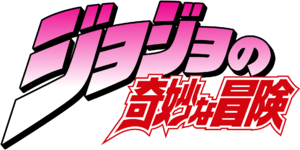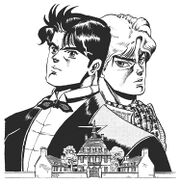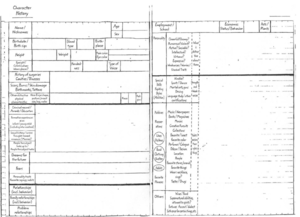JoJo's Bizarre Adventure/fr
Profil
JoJo a été sérialisé dans le Weekly Shonen Jump de 1987[1] à 2004 et a ensuite été transféré dans le magazine mensuel seinen Ultra Jump, où l'histoire continue actuellement. La série est collectée dans une variété de formats allant des Tankōbons standards aux volumes d'édition spéciale tels que Bunkobans et Kanzenbans qui contiennent tous le manga tel qu'il a été sérialisé dans Weekly Shonen Jump et l’Ultra Jump avec quelques différences telles que les noms de chapitres et les dialogues.
La série a plus de 100 millions d'exemplaires imprimés[2], ce qui en fait l'une des séries de mangas les plus vendues de l'histoire. Remplissant plus de 120 volumes, c'est la deuxième plus longue série de mangas de la Shueisha. La publication en français des parties a commencé en 2002 avec les éditions J’ai Lu et a été poursuivi en 2007 par les éditions Delcourt/Tonkam. La série est toujours en cours aujourd’hui.
Le genre de JoJo englobe l'action, l'aventure, le surnaturel, le thriller, la comédie, la tragédie, le mystère, la tranche de vie et l'horreur. Il est peut-être le plus connu pour son phénomène de Stand ; l'arc Stardust Crusaders et ses personnages Dio Brando/DIO et Jotaro Kujo ; la restitution expressive de personnalités fières et glamour ; et les centaines de références à la musique populaire occidentale.
Araki est l'auteur de plusieurs spin-offs et artbooks qui s’ajoutent au canon de JoJo à des degrés divers ; et plusieurs light novels (romans) ont également été produits, qu’Araki illustre.
JoJo était auparavant la plus longue série de mangas de Shueisha à n'avoir pas reçu d'adaptation animée pour la télévision. Cependant, la série télévisée animée officielle a finalement fait ses débuts le 6 octobre 2012 (séparant les débuts du manga et de l'anime de 25 ans) ; conçu par le studio d'animation David Production.
Sa gamme d’autres produits comprend plusieurs adaptations dans les jeux vidéo, dont trois jeux de combat de sortie internationale ; Heritage for the Future de Capcom en 1998; All Star Battle de Bandai Namco Games pour la PS3 en 2014; et Eyes of Heaven sur PS4 en 2016.
Guide
L'histoire de JoJo est divisée en deux continuités/univers. La première comprend les parties 1 à 6, détaillées dans le Weekly Shonen Jump de 1987 à 2003, tandis que la seconde comprend les parties 7 et 8, détaillées dans le magazine seinen Ultra Jump de 2004 à nos jours. L'intrigue à travers ces histoires est fournie dans des arcs de plusieurs chapitres détaillant les conflits précaires et mélodramatiques entre les parties définies à la fois par des pouvoirs surnaturels uniques, principalement par le phénomène polyvalent Stand, et des ambitions, attitudes ou normes morales exclusives. Ces arcs varient en ton, alternant aventure, suspense, mystère et horreur ; toujours à travers l'action, et avec une comédie souvent intégrée. En règle générale, une course contre la montre émerge parmi les héros pour intercepter le puissant antagoniste central.
De nombreuses références au cinéma moderne, à la télévision, à la mode, aux beaux-arts et à la musique populaire sont facilement identifiables à travers JoJo dans de nombreux contextes et à la fois dans la caractérisation et la nomenclature des personnages. Des exemples de théories physiques, mathématiques et psychologiques, de biologies, de technologies, de mythologies, de phénomènes naturels, d'événements historiques et de segments d'autres travaux artistiques informent la conception et la fonctionnalité de la multitude de stands uniques. La série fait parfois des développements fantaisistes sur les théories scientifiques contemporaines dans la création des voies par lesquelles certains Stands et d'autres pouvoirs exercent leur influence sur la nature.
Morioh, une ville japonaise fictive et le cadre de Diamond is Unbreakable avec sa version alternative dans JoJolion (toujours en cours) partage ses coordonnées avec la ville natale d'Araki, Sendai[3], en assurant une description plus détaillée culturellement et en faisant référence à des sujets plus contemporains (comme le tremblement de terre de Tohoku). De plus, le mangaka Rohan Kishibe, un habitant de Morioh présenté dans Diamond is Unbreakable, revient comme guide dans un certain nombre de spin-off de JoJo..
Lorsqu'on lui a demandé en 2006 de décrire le sujet de JoJo en une phrase, Hirohiko Araki a répondu "une énigme de l’être humain" et "un éloge funèbre à l'humain"[4] et son attitude envers le manga, "le salut du cœur ".[5] Les sujets du manga peuvent être condensés sous les thèmes du destin, du courage et de la justice.
Univers d'origine
La première continuité/le premier univers fait suite à une querelle intergénérationnelle entre la Famille Joestar et diverses forces du mal, dont la plus importante est Dio Brando et ses serviteurs.
Phantom Blood
La première partie Phantom Blood, qui se déroule en Angleterre en 1880, suit Jonathan Joestar qui combat son frère adoptif, le rusé et impitoyable Dio Brando qui devient un vampire avec l'aide d'un ancien masque de pierre. Jonathan est entraîné par Will Anthonio Zeppeli à l'énergie vibrante de l’Onde, manié dans le corps humain et transféré au corps à corps, qui est le seul moyen sûr, en dehors de la lumière du soleil, de vaincre les vampires et leurs sbires zombies.
Battle Tendency
La deuxième partie Battle Tendency voit le petit-fils de Jonathan, Joseph Joestar, traverser le monde dans les jours qui ont précédé la Seconde Guerre mondiale en 1938 pour combattre les Hommes du Pilier, une ancienne race d'êtres hostiles responsables de la création du masque de pierre. Comme son grand-père, Joseph suit un entraînement intense aux côtés de César Anthonio Zeppeli, le petit-fils de Will, par la secrète Lisa Lisa et tente de protéger la pierre rouge d'Aja, un joyau recherché par les hommes du pilier pour compléter le masque de pierre et leur accorder l'immunité contre le Soleil.
Stardust Crusaders
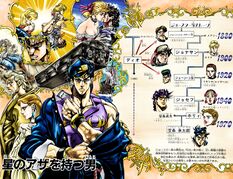
The three first parts constitute a trilogy after which Hirohiko Araki intended to end the series, but JoJo's Bizarre Adventure continued nonetheless after the end of the third part.[6]
Diamond is Unbreakable
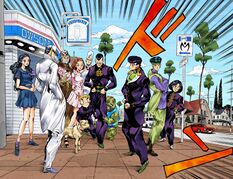
The fourth part Diamond is Unbreakable is set in the fictional town of Morioh, Japan, in 1999. It follows Joseph's illegitimate son Josuke Higashikata as he meets friends and enemies among a host of new Stand users within the population of Morioh created with the Bow and Arrow, two items which gave DIO his Stand. He, Okuyasu Nijimura, Koichi Hirose, Jotaro Kujo, and Rohan Kishibe eventually chase the serial killer Yoshikage Kira.
Vento Aureo
In the fifth part Vento Aureo, set in Italy 2001, DIO's son Giorno Giovanna fights his way to the top of Passione, the most powerful gang in Italy, as he plots to overthrow the gang's mysterious Boss in order to protect the civilian populace from the gang's drug trade. To do so he cooperates with gang member Bruno Bucciarati and his own team of Leone Abbacchio, Guido Mista, Narancia Ghirga, and Pannacotta Fugo as they are tasked with protecting the Boss' daughter Trish Una from the assassin teams Squadra Esecuzioni and Unità Speciale.
Stone Ocean
The sixth part, Stone Ocean, is set in 2011 as Jotaro's estranged daughter Jolyne Cujoh is framed for murder and imprisoned in Green Dolphin Street Prison. Jotaro then has both his memories and Stand stolen by the Stand Whitesnake after an attempt to free Jolyne. She then decides to stay imprisoned in order to find out both who Whitesnake's master is and what he plans to do with Jotaro's memories and Stand. Along her adventure, Jolyne gains allies in Emporio Alnino, Ermes Costello, Foo Fighters, Narciso Anasui, and Weather Report.
Alternate Universe Continuity
Steel Ball Run
Set in 1890 in the United States, Steel Ball Run follows a race across the continent of the United States of America. The race is called the Steel Ball Run horse-race and is named after the sponsor, Steven Steel. The protagonists are Gyro Zeppeli, a master of the unique Spin technique seeking the cash prize and Johnny Joestar a paraplegic ex-jockey seeking to cure his legs through the Spin, both cooperating to win the race. Johnny and Gyro discover that the race is a cover-up from the President Funny Valentine to uncover the powerful and invaluable relics of Jesus Christ, eventually also hunting for said relics while fending off Valentine's many agents.
JoJolion
Leaping to 2011 in JoJolion, university student Yasuho Hirose discovers an amnesiac man tentatively named "Josuke" in Morioh after the (then-contemporary) Great East Japan earthquake. Both then decide to investigate Josuke's past identity, initially thought to be that of the ship's doctor Yoshikage Kira, and the circumstances of his presence in town, leaving him in the care of the affluent Higashikata Family as both uncover the family's darkest secrets and a drug trade involving a mysterious race of humanoid beings and an equally mysterious fruit.
The second continuity features many nods to characters of the former continuity including restyled main characters, Stands and locations.
Parts
| No. | Title | Original Run | Volumes |
|---|---|---|---|
| 1 | 1987 – 1988 | 5 | |
| Beginning in 1880, Part 1 follows Jonathan Joestar as he matures with and eventually combats his adoptive brother, the cunning, merciless Dio Brando. | |||
| No. | Title | Original Run | Volumes |
|---|---|---|---|
| 2 | 1988 – 1989 | 7 | |
|
Set in 1938, Part 2 follows Joseph Joestar, grandson of Jonathan, who finds himself embroiled in a war against ancient super-beings named the Pillar Men, creators of the Stone Mask. | |||
| No. | Title | Original Run | Volumes |
|---|---|---|---|
| 3 | 1989 – 1992 | 16 | |
| Part 3, set in 1989, follows Jotaro Kujo, who has acquired the power of Stand, and his allies as they journey from Tokyo to Cairo to save his mother's life by defeating his family's archenemy, DIO. | |||
| No. | Title | Original Run | Volumes |
|---|---|---|---|
| 4 | 1992 – 1995 | 18 | |
|
In Part 4, set in 1999 in the fictional town of Morioh, high-schooler Josuke Higashikata and his friends seek out the Arrow, which has the power to give Stand abilities, as well as the serial-killer Yoshikage Kira. | |||
| No. | Title | Original Run | Volumes |
|---|---|---|---|
| 5 | 1995 – 1999 | 17 | |
| Part 5, set in Italy in 2001, follows the adventure of Giorno Giovanna, the son of DIO, in his ambition to rise within the Italian mafia by subverting the dominant gang Passione and its mysterious Boss with the aid of a team of fellow Stand users. | |||
| No. | Title | Original Run | Volumes |
|---|---|---|---|
| 6 | 2000 – 2003 | 17 | |
|
In Part 6, 2011, Florida, Jolyne Cujoh, daughter of Jotaro Kujo, is framed for murder and thrown in the Green Dolphin Street Prison. She and her allies struggle to discover who is responsible for what and what are they planning to do. | |||
| No. | Title | Original Run | Volumes |
|---|---|---|---|
| 7 | 2004 – 2011 | 24 | |
|
Beginning another continuity, Part 7 follows Gyro Zeppeli, master in a mystic art named the Spin, and Johnny Joestar, a paraplegic ex-jockey, as they compete with a vast number of others in the highly rewarded Steel Ball Run race in the U.S. in 1890, designed in part by the American government. | |||
| No. | Title | Original Run | Volumes |
|---|---|---|---|
| 8 | 2011-Ongoing | 24 | |
|
Part 8 begins in 2011 and follows Josuke Higashikata, a young man afflicted by retrograde amnesia, on his search to uncover his identity in Morioh, a coastal Japanese town affected by the Tohoku earthquake. | |||
Publication
Chapters are serialized in Weekly Shonen Jump and Ultra Jump, under Shueisha. While in Weekly Shonen Jump, the series was published under the tagline "Romantic Horror! -A Crimson Tale-" (ロマンホラー!—深紅の秘伝説—, Romanhorā!-Shinku no hi densetsu-). The tagline was created by the editorial department at Shueisha and was included in every chapter up until Stone Ocean.
In North America and the United Kingdom, Stardust Crusaders was translated into English and published in 16 volumes by VIZ Media from November, eighth 2005 to December 7, 2010 under the title of JoJo's Bizarre Adventure, skipping both Phantom Blood and Battle Tendency. On June 9, Viz Media published the first three parts of JoJo's Bizarre Adventure from the JoJonium line of manga, from February 24, 2015 to February fifth, 2019, marking the first English publications of Phantom Blood and Battle Tendency. On July 6, 2018, Viz Media announced they would be releasing an English publication of Diamond is Unbreakable. The first volume of Diamond is Unbreakable was released on May 7, 2019. Diamond is Unbreakable is still currently being released.
In Italy, Star Comics began publishing the series in a monthly format under the title Le Bizzarre Avventure Di JoJo from November 1993 to April 2004,[7] these monthly releases contained around five chapters in each trade paperback with 126 paperback volumes released. These releases would then be followed up in March 2006 with translations of the Steel Ball Run volumes that were published until February 2012. During this time, Star Comics published the JoJo's Bizarre Adventure (Bunko Edition) volumes with their Italian translation of the series starting from 2010. Currently, they have been publishing JoJolion since February 2014 and have begun releasing the JoJonium volumes since October 2019 with further releases still on-going.
In France, the first four parts were published by J'ai lu[8] from January 2002 to December 2005. In 2007 publisher Tonkam (now a subsidiary of editions Delcourt resumed the publication of the following parts starting with a publication of Vento Aureo, the previous parts would later see revised releases under Tonkam's publication starting with Stardust Crusaders and then going back to Phantom Blood and continuing from there. Currently, they are publishing JoJolion.[9]
In Spain, the entire series is being published by IVREA. Phantom Blood started publication on June 30, 2017. This publication uses the same volume count as the Bunko Edition volumes, these volumes come out monthly. They are currently publishing Stone Ocean as part of their publication.
In Argentina, the first four parts are being published by IVREA Argentina.
In Mexico, the first five parts are being published by Panini. Publication started on August 1, 2018 with Phantom Blood using the same volume count as the Bunko Edition volumes, these volumes come out monthly. The current part in publication is Diamond is Unbreakable.
In Brazil, the first three parts are being published by Panini.
In China, JoJo was illegally distributed under the title Strongman Front (強人陣線) by Tong Li Comics for many years until Daran Comics obtained the official publishing license for JoJo, renaming the comic JoJo Adventure Wild (JoJo冒險野郎). On March 31, 2003 Daran Comics shut down their offices and their license for JoJo was officially obtained by Tong Li Comics who now officially distributes the series in Taiwan and reverted the title of the series back to JoJo's Bizarre Adventure (JoJo的奇妙冒險). Currently, the series is being published by World Publishing Limited as they are currently releasing a publication of JoJolion.[10]
Making-of
When he first conceived JoJo's Bizarre Adventure, Araki was throwing around several core ideas he wanted to portray such as an idea of succession between generations, but also to show travelling heroes. From there he began to set up his ideas for Phantom Blood. Araki notes that the process of creating JoJo went from fight to a more spiritual aspect, and that concepts like friendships took a greater place over time.[11] Araki had several themes in mind too, such as the idea of "mystery",[12] and notably the mystery coming from bloodlines. He also asked himself "Who is the strongest person in the world?" and derived from this question themes such as immortality, seeking life, or justice.[12] More importantly, Araki felt that he could create something unique among the current series at Weekly Shonen Jump with these ideas. Araki had initially only planned for three parts,[13] but decided to continue with his series.
Writing JoJo
Araki gives precedence to emotion and inner thought over plot structure, trying to portray the protagonists' destiny.[14]
Araki follows a particular narrative style called the "golden road", characterized by strong and determined protagonists who constantly advance towards their objectives. This "golden road" is, according to him, the best way to draw in the audience. One example of his "golden road" is the plot of Stardust Crusaders during which the heroes always manage to defeat the enemies on their paths and inexorably approach Egypt. Araki is not avert to killing off his protagonists like Jonathan Joestar but feels that if the death served a greater purpose then he still abides by the "golden road".[15] Araki thinks the basic plot of his parts around a particular predicament and likes to throw his protagonist quickly into said predicament before continuing off his story from there (e.g. Johnny Joestar is paraplegic and wants to find a way to heal his legs).[15] Araki also use a rather original plot structure for the series. Instead of the classical "tournament" format of most other series at the time where the heroes fought enemies in a predictable increasing order of strength, Araki adopted a sugoroku style (sugoroku is a table-top game similar to snakes and ladders) where the heroes would travel and then meet enemies at particular points in said journey and the fights would be more varied due to a better variety of powers, and an emphasis on wit rather than force.[16] Araki also denounces the long-term limitations of always increasing the strength of enemies in a serialized manga.[17][12]
Araki takes inspiration from a variety of sources to write his series. He has confirmed several times that he uses Western music to name his characters, but also copies designs from varied sources such as artbooks, comic books, the news, or movies. Araki extensively uses books rather than online research.[18] One lesser known aspect of his research is that he often travels to the places he depicts in the series in order to have a better feeling of the place and gather details that an online research wouldn't give. His first tanto Ryosuke Kabashima encouraged him to see movies for inspiration and also travel.[19] Kabashima notably coerced Araki into travelling to Egypt to later depict it in Stardust Crusaders.[20] Araki would later on keep this habit and went to Italy for Vento Aureo[21] and went to a correctional facility in Florida too to get inspiration for Green Dolphin Street Prison,[22][23] as well as Orlando.[24] He also went on several long journeys in the USA and Japan to better write Steel Ball Run too.[25] His habit of travelling to research places extended to individual buildings such as a hospital or a drug store.[26]
Araki makes it a point to never rest on his laurels and always find new ideas. For instance, Araki was displeased to think he had reached a summit with Stone Ocean in terms of idea and had decided to erase the original continuity and revisit his old ideas in a second continuity.[27] His will to always change is also notable on his art (though he explains it as avoiding drawing old art rather than deliberately change).[28] Araki's art style has changed considerably over the years, although he had always kept core ideas about his art such as his dramatic poses and representation of an ideal human body. For instance, muscle-bound heroes were popular in the 80s so Araki drew these types of characters (e.g. Jonathan), but as trend changes, Araki transitioned to more normal-looking characters like Giorno, a slimmer pretty boy character type.[29][11] The unusual sound effects Araki inserts in his page are inspired from horror movies and rock music, akin to scare chords and other noises produced by synthetizers and mellotrons.[29]
During its publication in the Weekly Shonen Jump magazine, Araki continuously tried to push for unique ideas, often infringing on what was considered acceptable for the magazine. Araki notably decided to make his first protagonist a foreigner and then kill him off to replace him, which was a taboo. Araki also had tried to write female protagonists for the series, with notably Giorno Giovanna being initially thought as a young woman. This would be eventually portrayed with Jolyne Cujoh, whose sex he insisted on despite his editor's requests. Araki notably thought that it was then acceptable to portray women being subjected to violence as intense as male characters were being exposed to.[30][29] It led to several conflict with the editorial team who tried to tone down the violence and themes Araki wanted to write about.[31]
When Araki creates a character, he thoroughly completes a datasheet about said character, which includes their physical characteristics, their tastes, and background information like a potential family.[32] Araki notes that his habit of naming characters after bands and albums is a simple hobby, and a way to pay his respect to the musicians he likes.[12]During his time at the Weekly Shonen Jump, Araki had the following schedule: Sundays were spent finding ideas, Mondays were spent making the draft storyboard for the chapter. He then met with his editor and began drawing more elaborate sketches, one page at a time. Tuesday, Wednesday and Thursday were spent finishing drawing the chapter for the publication of the Weekly Shonen Jump magazine, and Friday and Satudary were spent resting.[33] This schedule that Araki followed strictly was set up by Kabashima too.[19] This notably allowed Araki to keep in shape, and he was also noted as being always on time for his chapters.[34] His current monthly schedule is unknown but Araki says that his current 45 pages a month match his natural pace better.[18]
Trivia
- List of cultural references in JoJo's Bizarre Adventure
- List of cultural references and inspirations from JoJo's Bizarre Adventure
- The 25th year of JoJo's continuous publication is commemorated in part by a booklet titled 25 Years With JoJo, featuring fan art by mangakas including Eiichiro Oda, Akira Toriyama, and Osamu Akimoto.
References
- ↑ Note: First issue was released in stores on December 2, 1986 - Weekly Shonen Jump #940 - No. 1-2, 1987
- ↑ http://www.araki-jojo.com/1151/
- ↑ Morioh Map (JoJolion)
- ↑ [Question for Araki-sensei! (13): "If you can describe JoJo in a single word"] - comipress.com, 2007
- ↑ [Question for Araki-sensei! (9): "If You Can Describe Manga in A Single Word"] - comipress.com, 2007
- ↑ JoJonium Special Interviews: Volume 8, Jotaro Kujo
- ↑ https://it.wikipedia.org/wiki/Le_bizzarre_avventure_di_JoJo First Italian release November 1993
- ↑ http://fr.wikipedia.org/wiki/J%27ai_lu
- ↑ https://www.editions-delcourt.fr/auteur/araki-hirohiko.html
- ↑ [1] Chinese Wikipedia page for the JoJo series
- ↑ 11.0 11.1 Animeland Interview 06/2003
- ↑ 12.0 12.1 12.2 12.3 Tokai Lecture 06/2006
- ↑ Weekly Shonen Bracket 100Q
- ↑ Tokai Lecture 06/2006
- ↑ 15.0 15.1 Hirohiko Araki's Manga Technique chapter 4
- ↑ NYT Japan interview 11/2018
- ↑ Volume 45, Volume 46 Author's note
- ↑ 18.0 18.1 Dream Talk Sessions 2015
- ↑ 19.0 19.1 JOJOVELLER History 1979-2013
- ↑ Manga Heaven 06/2007
- ↑ Author's Note (Vento Aureo) vol.48
- ↑ SO Volume 1 special thanks
- ↑ SO Volume 5 Author's Note
- ↑ SO Volume 12 Author's Note
- ↑ P7 Bunko 1 afterword
- ↑ Volume 41 Author's Note
- ↑ P6 Bunko Vol.11 Afterwords
- ↑ JOJOmenon interview
- ↑ 29.0 29.1 29.2 PS2 Game interview
- ↑ P6 Bunko Vol.1 Afterwords
- ↑ P5 Bunko Vol.1
- ↑ Manga in Theory and Practice chapter
- ↑ JoJo6251 Araki interviews
- ↑ JOJOVELLER 2013 Azuma interview
<languages/>

